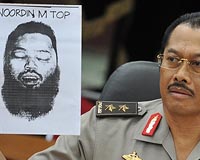| . |  |
. |
Mogadishu, Somalia (UPI) Oct 25, 2010 Just as the Islamist al-Shabaab militia in Somalia seemed on the verge of driving the Western-backed Transitional Federal Government out of the capital Mogadishu, the insurgents' offensive looks like being crippled by a split between rival factions. The schism has clearly undermined the offensive, although it had been faltering in recent days because of mounting insurgent casualties. At the same time, fighting in central Somalia between al-Shabaab and more moderate Ahlu Sunna wa'l Jamma militia also stalemated. "The failure of al-Shabaab's Ramadan offensive, intended to rout Somalia's TFG from Mogadishu, appears to have led to a major rift between the group's emir, Sheik Ahmad Abdi Godane, 'Abu Zubair,' and his deputy, Sheik Mukhtar Robow, 'Abu Mansour'," according to the Jamestown Foundation, a Washington think tank that monitors global security. Islamist officials sought to downplay the extent of the split but it seems clear that Abu Mansour is breaking from Godane's forces. The U.S. global security consultancy Stratfor viewed the split as between al-Shabaab's "nationalist and internationalist elements." Godane is considered the leader of the global jihadist forces in Somalia, "coordinating closely with foreign jihadists from al-Qaida who have joined the ranks over the last few years," Stratfor noted. His group "has been the primary force battling the Somali government in recent years and is responsible for propelling the Somali theater onto the global jihadist radar." Abu Mansour is considered to be aligned with nationalist elements within al-Shabaab, "though like Abu Zubair, his fighting background is also transnational, having fought with the Taliban in Afghanistan." Abu Mansour could now join forces with al-Shabaab's main Islamist rival, Hizb al-Islam, led by Sheik Hassan Dahir Aweys, a staunch Somali nationalist, "to restore a previously active militant group called al-Itihaad al-Islamiya, Stratfor said. "The breach would weaken al-Shabaab but a new AIAI would not necessarily be welcome by the Somali government and its backers." Even so, the rift is a serious setback that could give the beleaguered TFG some relief. However, it, too, is troubled by clan-driven rivalries as well as poor leadership, much to the dismay of the United States and the United Nations, its main backers. These developments could well change the complexion of the Horn of Africa conflict that some feared could become an arena in the war against terrorism. But it is unlikely to end the anarchy that has plagued the country since the fall of dictator Mohammed Siad Barre in 1991. The rift emerged after several months of fighting during which al-Shabaab steadily advanced into the isolated government-held sector of Mogadishu around the presidential palace, the port and airport. But in recent days, remnants of the defection-plagued TFG army and a strengthened African Union peacekeeping force, the government's main defense, succeeded in pushing back the insurgents back in some sectors. By all accounts, al-Shabaab suffered considerable casualties in the street fighting, although exact figures aren't available. But the losses were apparently enough to aggravate festering rivalries within the clan-based Islamist movement over strategy and policy. These differences, and ever-present competing clan loyalties, had been glossed over when the insurgents were gaining ground. Abu Mansour's forces, some 2,000 strong and mainly from southern Somalia, suffered the heaviest casualties because they had been pushed into the front lines by northern commanders. That caused friction, reopening age-old tribal differences. The rift deepened after one of Abu Mansour's commanders, Sheik Ayub, went missing. Eventually, Jamestown reported, Abu Mansour learned that Sheik Ayub had been badly wounded in the street battles and was then killed by Godane's special forces unit, known as Amniyaat, "to ensure he would die a martyr." Jamestown observed that "there are questions within al-Shabaab regarding financial improprieties and the appointment of members of Godane's northern Isaaq clan to key positions within the movement." Abu Mansour was later reported to have met Aweys to discuss a possible alliance against Godane. "All these top leaders -- Abu Zubair, Abu Mansour, Aweys -- are designated terrorists by the U.S. government, and each has fought in Somalia, regional or international Islamist campaigns," Stratfor observed. "Neither the TFG nor Washington would like to see any of these men in any leadership role."
Share This Article With Planet Earth
Related Links The Long War - Doctrine and Application
 Indonesia launches torture investigation
Indonesia launches torture investigationJakarta (UPI) Oct 25, 2010 Indonesia's military has promised an investigation into the torture of several Papuan villagers, an act caught on video and circulated by a human rights group. The authenticity of the 10-minute graphic video initially was questioned by Indonesian authorities, saying it was a propaganda stunt by separatist groups in Papua, the country's eastern-most and largest province. The Asian ... read more |
|
| The content herein, unless otherwise known to be public domain, are Copyright 1995-2010 - SpaceDaily. AFP and UPI Wire Stories are copyright Agence France-Presse and United Press International. ESA Portal Reports are copyright European Space Agency. All NASA sourced material is public domain. Additional copyrights may apply in whole or part to other bona fide parties. Advertising does not imply endorsement,agreement or approval of any opinions, statements or information provided by SpaceDaily on any Web page published or hosted by SpaceDaily. Privacy Statement |